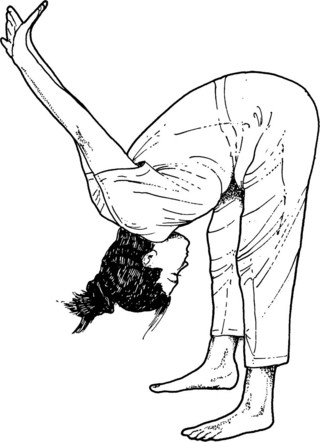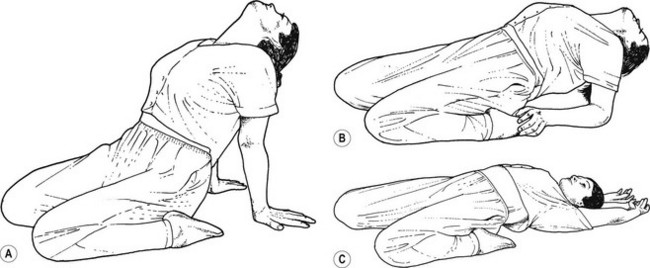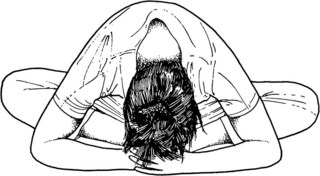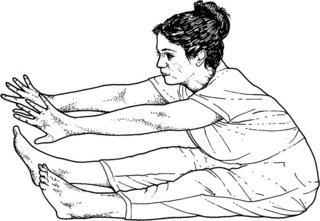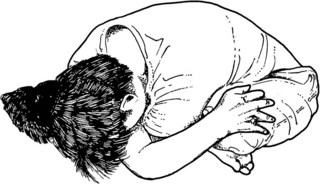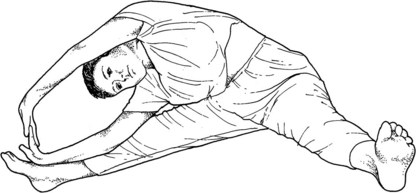CHAPTER 20 After the session
Ideally, the receiver should be covered with a blanket after the session, if she is not already, and allowed to rest for a few minutes. We can use this time for writing up the relevant details on the treatment and its results in the case notes. It may be helpful to jot down any suggestions for the next session at this stage, while the experience is still fresh in our minds. Some practitioners offer a cup of herb tea at this point; but it is best not to commit yourself to the degree that one practitioner did when first starting out; after the treatment session, she would offer the receiver a hot bath and a cheese sandwich!
Type 1 Recommendations: Points and Meridian Exercises
Meridian exercises: the Makko-Ho
Lung and Large Intestine
Stand with your feet shoulders’ width apart, knees ‘soft’ (not locked) and link your thumbs behind your back. Breathe deeply into your Hara. Stretch your fingers out and imagine your body filling with Ki to the fingertips. Now breathe out and, as you do so, bend forward into the position shown in Figure 20.1, keeping your fingers stretched out, and relaxing as much as you can.
Stomach and Spleen
Stage 1
Kneel on a padded surface such as a thick carpet or futon; sit between your heels if possible, sit on your heels if you cannot sit between them, and sit on a cushion placed between your ankles if you can do neither. Breathe deeply into the Hara. As you breathe out, rest your hands facing backward on the floor behind you, and lean your torso backwards. Relax your neck and let your head fall back (Fig. 20.2A). Look behind you, rolling your eyes upward. Repeat for two cycles of breath. This stage of the exercise stretches the upper part of the Stomach and Spleen meridians, in the chest, throat and face, and the lower part in the knees, shins and feet.
Stage 2
On the next outbreath, lean back further on to your elbows. Continue to keep your head relaxed backwards. Stay in this position for two cycles of breath. This position stretches the meridians down to the groin (Fig. 20.2B).
Stage 3
On the next outbreath, if you can, lay your body back on to the floor, with your arms stretched above your head. Relax for two cycles of breath. This final stage stretches the front of the hips and thighs, and increases the stretch to the rest of the body. The stretch is increased the more your knees are drawn together (Fig. 20.2C).
Heart and Small Intestine
Sit on the floor, with the soles of your feet touching, your legs relaxed outwards and your back upright. Breathe in deeply and clasp your toes. As you breathe out, relax your head, neck and torso forward between your knees, allowing your elbows to relax towards the floor (Fig. 20.3). Stay in the position for two cycles of breath, allowing yourself to relax into it more on each outbreath, and come up on the fourth outbreath.
Kidneys and Bladder
Sit with your legs straight out in front of you, but relaxed outwards. Breathe in and, as you do so, stretch your whole spine upwards and stretch your arms above your head, palms facing out. Breathe out and, as you do, lean forwards, flexing at the hips but with a straight back and straight legs. Breathe in again into your Hara and, as you breathe out, reach as far forward between your feet as you can (Fig. 20.4). Imagine the motive force propeling you forward from your sacrum.
Heart Protector and Triple Heater
Sit cross-legged, with your back straight. Cross your arms and place your hands on your knees, with the outside arm on the same side as the outside or uppermost leg. Breathe in deeply and, on the outbreath, relax your body downwards towards the floor. Allow your hips to spread and settle if you do not feel enough of a stretch, or ‘walk’ your hands further apart on your knees (Fig. 20.5).
Liver and Gall-Bladder
Sit on the floor, with your legs as far apart as you can while keeping your spine upright. Link your fingers and stretch your arms above your head, palms up. Breathe in deeply and turn to look at your right foot. Breathe out and lean your body sideways towards your left, stretching your arms out towards your left foot. Look upwards rather than down in order to stretch the sides of your torso and neck. Hold the position and relax into it for two cycles of breath, then come up on the fourth outbreath and repeat the sequence to the other side (Fig. 20.6).
Type 2 Recommendations: Lifestyle Changes
The field of recommendations is as wide as your experience, and if you have other areas of expertise such as physiotherapy, herbs or nutritional supplements, you will obviously be able to make appropriate recommendations from your own specialist viewpoint. If you have no such special skills, however, you can take heart from the knowledge that if the yuan (see p. 24) between you and the receiver is good, simply recommending a glass of hot water and lemon every day before breakfast will have a strong healing effect.
Stay updated, free articles. Join our Telegram channel

Full access? Get Clinical Tree


